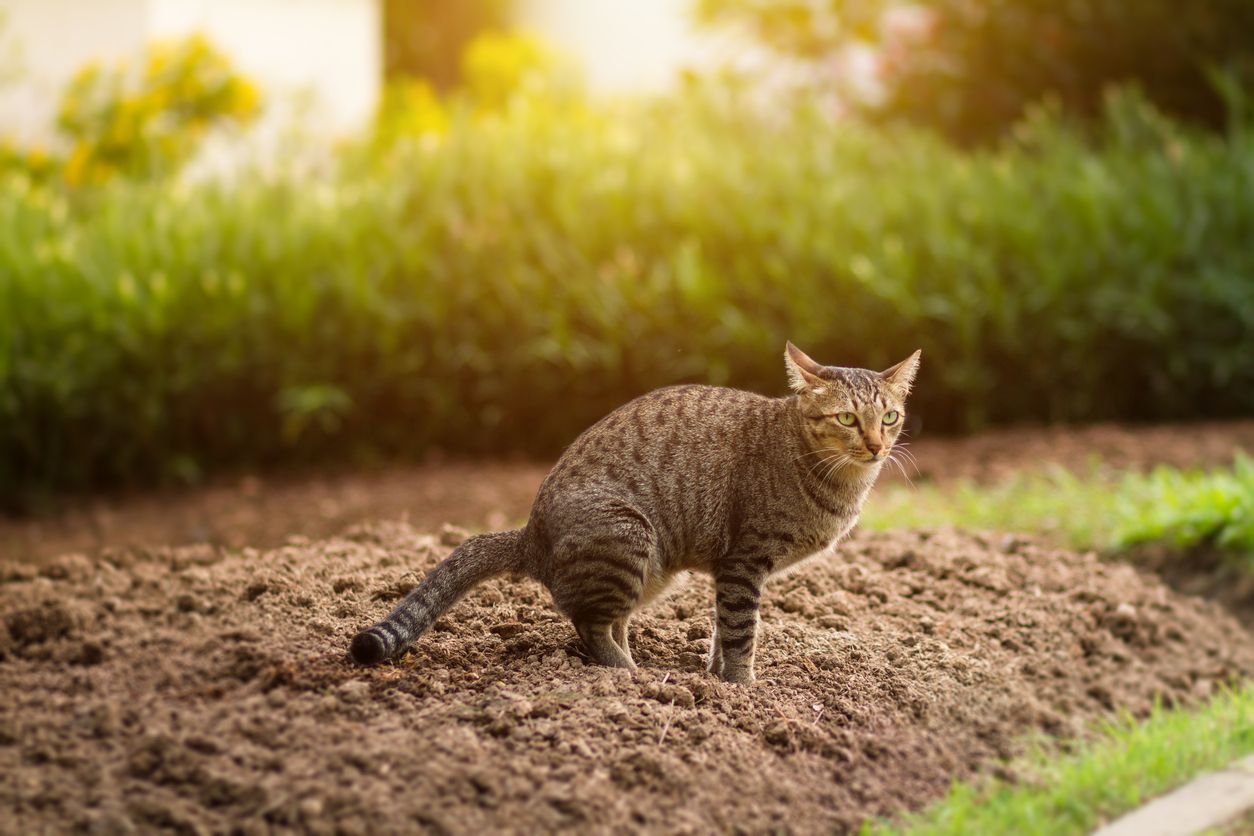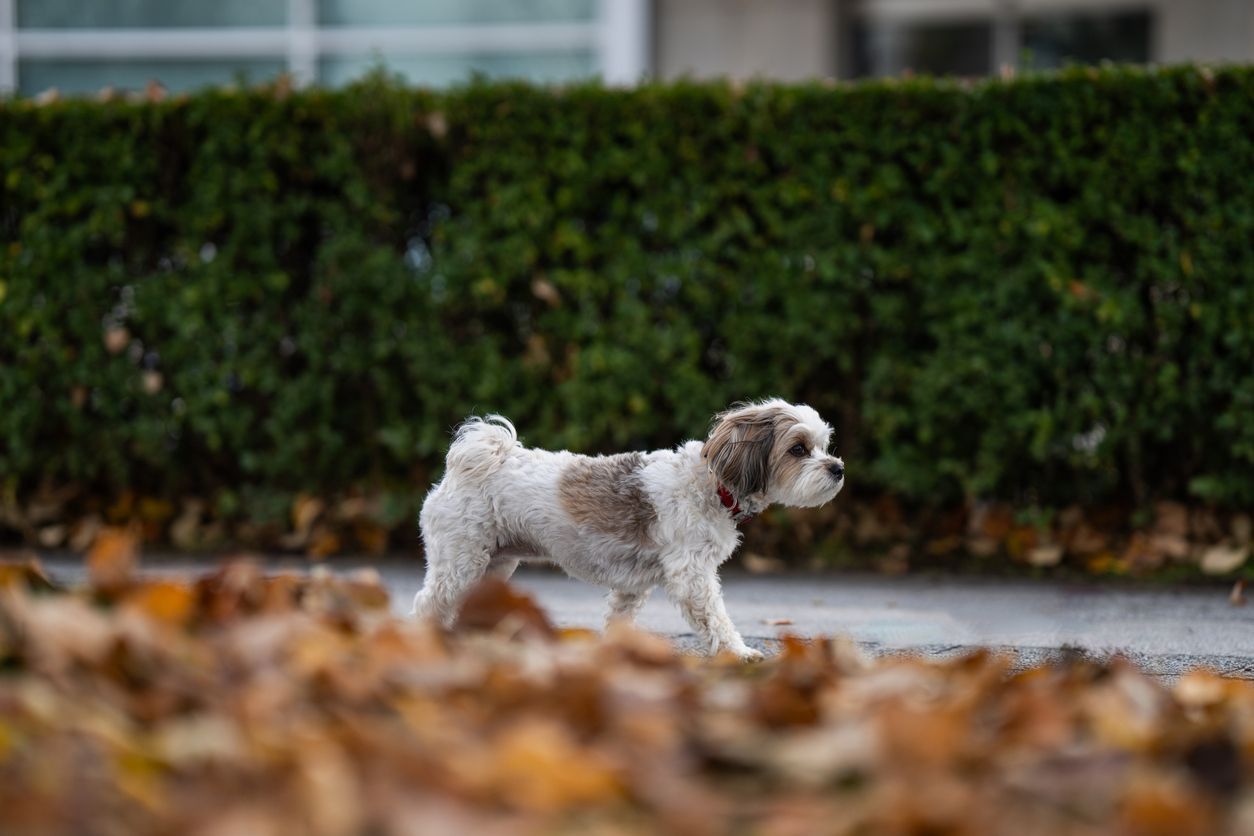When to see a vet for cat constipation

Disclaimer: This article, its content, and its related references do not constitute veterinary advice and should not be considered a substitute for veterinary care.
We all experience constipation from time to time — even cats. Often, this is a temporary condition that isn’t cause for concern. However, if constipation lasts longer than two or three days, it can be dangerous if left untreated. Read on to learn more about:
- When to take your cat to the vet for constipation
- What vets do to treat constipation in cats
- When cat constipation is an emergency
Constipation can be a common occurrence in cats — especially older cats — but by paying close attention to your cat’s behavior and proactively visiting your vet, you can prevent further problems. If left untreated for too long, the blockage could affect the function of your cat’s colon. If constipation doesn’t clear on its own within 48 hours, you should call your vet. Your vet might prescribe a change in diet, a laxative, or some other course of action.
When constipation in cats is an emergency
Constipation in cats is an emergency if symptoms have lasted longer than 48 hours. In most cases, constipation is not an emergency and will clear on its own if your cat is getting enough water. It’s usually okay to wait a day or two after symptoms appear before labeling it as a veterinary emergency. If any symptoms last longer than 48 hours or your cat appears to be in clear discomfort, see your vet as soon as possible.
Symptoms of constipation in cats can include:
- Firm, dry feces
- Lack of feces
- Straining to defecate, sometimes accompanied by dry feces, no feces, or small amounts of liquid feces or blood
- Lethargy
- Loss of appetite
- Vomiting
Similar to humans, the occasional episode of constipation in cats is generally not cause for concern. They could be backed up due to dehydration or an obstruction caused by indigestible material, like a bad hairball.
However, constipation can also be caused by medical conditions like megacolon, an enlarged prostate, or sublumbar lymph nodes that require treatment from a veterinarian. Your vet will be able to assess the situation and determine the cause and severity of the constipation.
Vetster for Quick 24/7 Online Vet Appointments
Vetster’s licensed veterinarians are available 24/7 to assess your cat's condition, providing online vet care when needed. Whether the condition is mild or severe, our experts can determine the appropriate course of action, including prescriptions or medical intervention, ensuring your pet promptly receives the care it needs.
Signs your cat may be constipated
Firm, dry feces
Keep an eye on whether your cat’s stool is unusually hard and dry. In most cases, the issue can be easily treated or will go away on its own, but if left too long, feces can continue to get harder and drier and more difficult to pass. This can lead to more severe conditions like megacolon or obstipation — a severe form of constipation — where the feces gets completely stuck and can result in permanent loss of function in the colon.
Lack of feces
A complete lack of feces or a noticeable decline in feces after a 48-hour period may be a sign that your cat’s stool is simply too hard to pass or that there’s an obstruction. Make an urgent appointment with your vet so they can check out the situation.
Noticeably straining to defecate
If your cat is straining or crying out in pain, pay attention to whether the straining is accompanied by dry, hard stool, liquid stool, or no stool. A lot of cat owners don’t realise that excessive straining can produce small amounts of liquid stool or blood that can be mistaken for diarrhea.
If you notice your cat straining to produce small amounts of liquid stool or blood, this is generally due to constipation, and what’s actually happening is small amounts of liquid feces is being squeezed out around the harder feces. This kind of straining can result in abdominal pain for your cat, so that’s another reason to see your vet and get to the bottom of the issue (pun intended).
It’s important to note that straining to defecate can sometimes look like straining to urinate, which is always an emergency in cats. If you notice your cat is having trouble producing urine, you should take them to a vet immediately.
Other signs and symptoms
Along with firm dry feces, a lack of feces, and noticeably straining to defecate, there are other signs you should watch out for, including:
- Lethargy and depression
- Loss of appetite
- Vomiting
One of the reasons cats get constipated is dehydration. This along with the general discomfort and pain of constipation can cause symptoms like lethargy and depression. Abdominal pain and discomfort can also reduce appetite and cause your cat to eat less or vomit up undigested food.
If your cat is eating less but still eating, it’s important you monitor them closely, and if their appetite isn’t back to normal after 48 hours, you should make an urgent appointment to speak to a vet. It’s important to know that cats shouldn’t go more than 24 hours without eating.
How can an online vet help my cat’s constipation?
If you’ve started to notice symptoms of constipation but it hasn’t been 48 hours, an online vet is a good first step to take. They’ll be able to help explain what to watch for and which symptoms might mean urgent care is required.
A virtual vet will ask you questions about your cat’s current state and explain what certain symptoms might look like. They’ll help you understand how to identify signs of an emergency, and what to do if your cat’s current state doesn’t improve. An online vet might recommend some at-home solutions to try based on your cat’s symptoms, or they may suggest simply monitoring your cat for signs of improvement or decline. It’s important to note that any at-home treatment should not be administered without recommendation from a vet.
How can an in-person vet help my cat’s constipation?
The treatment that a vet prescribes will be different based on the severity of the constipation. They might need to administer an enema or even manually remove the stuck feces, which often involves an anesthetic or sedative for your cat so they can feel better without experiencing the procedure.
After the stool has been removed, your vet may prescribe a high fiber diet, lubricant laxatives, or stool softeners to help prevent constipation from recurring. In more severe cases, your vet may prescribe a long-term medication to increase the contractile strength of the large intestine.
Sometimes, these medical therapies aren’t successful in treating constipation, and your vet may want to perform tests to diagnose the cause and to help find a potential solution. This could include X-rays, blood work, and urine testing to look for underlying conditions that might be causing or contributing to your cat’s constipation.
What does constipation look like in kittens?
Kittens that are less than 3 or 4 weeks old need stimulation to urinate and defecate. After this, however, they should be able to pass stool on their own at least once every 24 hours. Constipation in kittens can be very serious and you should see a vet if your kitten hasn’t had a bowel movement in more than 24 hours.
The signs of constipation in kittens are the same as in adult cats, but it’s important that you keep a closer eye on things.
How long you should wait before seeing a vet
For mild cases of constipation, it’s okay to wait about 48 hours before seeing a vet. This is because the symptoms associated with mild, short-term constipation are typically temporary and may resolve on their own without treatment. Hydration is important in these cases, so make sure your cat has easy access to clean, fresh water. An online consultation is a good way to ease your mind and to learn more about the signs and symptoms to watch for.
Why at-home treatments may not work
Every treatment and medication has pros and cons and should only be used as needed. Here are some common treatments that you might learn about and what you should know about their use.
Adding fiber
Insoluble fiber, like cellulose, pumpkin, and psyllium, works by increasing the bulk of stools in order to stimulate colon contraction. However, in doing this, the insoluble fiber actually lowers fecal water content even more, which may lower your cat’s ability to digest nutrients.
Soluble fiber, like flaxseed, can lead to diarrhea, which also can also decrease nutrient absorption.
Lubricant laxatives
Lubricant laxatives, such as mineral oil and white petrolatum, are a common treatment for constipation as they do just what it sounds like — lubricate where needed. However, these laxatives can cause aspiration pneumonia when ingested orally by cats. You may be tempted to try administering an enema on your own at home — don’t. This is a tricky, messy, and uncomfortable procedure that should be done by a veterinary professional.
What you can do at home to help your cat’s constipation
The best thing to do for your constipated cat is to make sure they have easy access to clean, fresh water (add extra water bowls in accessible spaces around your home). Watch your cat closely and call your vet if their constipation lasts longer than 48 hours or if symptoms appear to get worse.
It’s best not to change your cat’s diet or give them any supplements unless instructed by a vet. Your vet will explain why a certain treatment is or is not appropriate for your cat based on your cat’s individual situation.
Length of treatment expectations and signs of improvement
Cat constipation, in most cases, will clear on its own in about 48 hours without any treatment. Providing your cat with easy access to clean, fresh water can help expedite the issue. You’ll know your cat has improved if they start producing normal-looking feces in their litter box. If they’re showing any behavioral changes, like lethargy or loss of appetite, you should see those behaviors return to normal as well.
If you’ve seen your vet and they’ve provided your cat with treatment, it shouldn’t take more than a couple of days to see the results. If your cat is still constipated after a vet has administered treatment, then a more intense treatment might be needed.
Check out Vetster’s other resources on cat constipation
FAQ - When to see a vet for cat constipation
Is cat constipation an emergency?
Most often, constipation in cats is not an emergency — simply an uncomfortable couple days for your cat. However, if you notice that constipation has lasted longer than 48 hours or that symptoms have gotten worse, your cat should see a vet. Constipation can be dangerous if it doesn’t get cleared, and it’s often a sign of another underlying disease.
Can I treat constipation on my own at home?
Simply put — no. If you think your cat is constipated, put easily accessible water bowls around your home and ensure your cat’s litter box is always clean. If these simple things don’t work and your cat’s constipation lasts longer than 48 hours, then call a vet. You should not administer any supplements or medications to your cat or change their diet without instructions from a veterinary professional.
How do I know if my cat is constipated?
The most common signs of constipation are hard, dry stools or none at all. You may notice your cat straining to use their litter box, and they may cry out in pain. They may seem lethargic and show a loss in appetite. One misleading symptom of constipation can be liquid stools, which is often mistaken for diarrhea but is actually a result of your cat straining so hard that a small amount of liquid feces squeezes around the dry stool that’s stuck in their colon.




